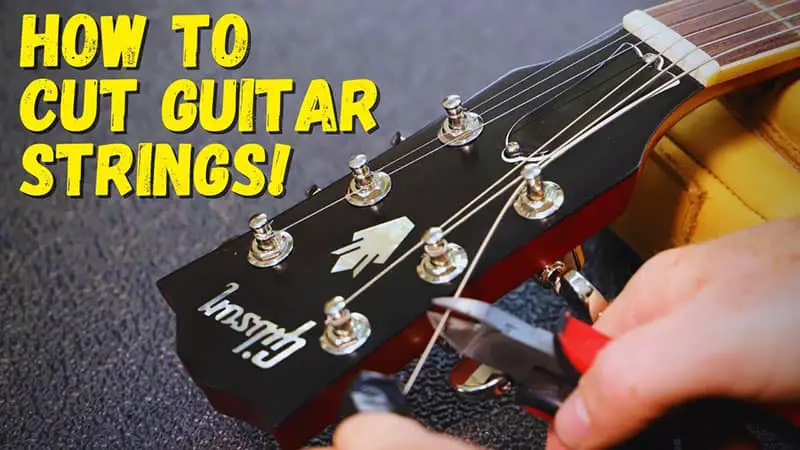Whether you’re a newbie or a pro, one thing you have to know for certain. That is your guitar strings need to be changed regularly. Old strings may rust, tarnish, stretch and thus change your guitar’s tone for the worse. Replacing the old ones with newer strings, you’ll get a completely new and better sound.
And the changing process includes cutting and restringing your guitar. Cutting the excess string at the end will reduce the risk of scratching the guitar or yourself. But how to cut guitar strings properly? And how do you know if it’s too short? Or too long?
That’s why we are here with step-by-step instructions to help you understand the process better.
How to Cut Guitar Strings
Why Cut Guitar Strings
Before learning how to cut guitar strings, you may ask why you need to cut them.
Maybe you need to change your set of strings or maybe you just want to try out some lighter or heavier gauge. There could be any reason for replacing your guitar strings. And you need to cut and remove them before installing new ones.
Also, you should cut the little extra bits at the end of the new strings. Many musicians prefer to have the extra string end picking out, and some even enjoy coiling it into a ring. But it’s a health hazard, to be honest. You don’t know when you’re gonna poke others with the sharp end or get injured yourself. It’s better to avoid all that risk and keep the string end nice and trimmed.
Ways to Cut Guitar Strings
String Cutter
The easiest way to cut guitar strings would be to use a string cutter. It is available in most music shops so you just need to visit your neighborhood guitar store and buy the string cutter.
And not just guitars, you can use your string cutter to cut the strings of different stringed instruments. You’ll be saved from a lot of headaches when it is time to restring your guitar.
Alternatives to String Cutter
If you have a string cutter already then you don’t need to worry about cutting strings. But what if you don’t have a string cutter present?
In this case, check out the alternative ways you can cut strings during a restring emergency.
Wire Cutter
The most popular alternative to string cutter is definitely the wire cutter. Most people have a wire cutter or two at their home. Due to its easy access and availability, many guitar players use it to cut the strings.
Wire cutters are different from string cutters but have a similar functionality. As they can perfectly produce sharp cuts like string cutters. That’s why some people don’t bother with a string cutter and continue cutting their strings with wire cutters.
If you don’t have a string cutter or don’t want to buy one, you can just use the wire cutter available at home. The outcome would be the same.
Pliers
Another household tool like wire cutter which you can use to cut guitar strings. Most standard pliers have a cutting edge at the bottom that you can utilize. Position the pliers deep enough, and you’ll be able to cut the strings.
Even without cutting edge, you can use the pliers in the classic way. Instead of cutting the strings, you’ll be able to bend and then break the strings.
Pliers are an easy and simple solution as almost everyone has one lying around at home.
Scissors
Scissors are another great tool for cutting strings, but you need to make sure the scissors you’re using is sharp enough.
Any standard pair of kitchen scissors or barber’s scissors work fine for this job. Using scissors won’t be hard at all as you can easily cut in a proper position. Similar to wire cutter, you can cut the strings at the exact point that you want to cut off.
Besides, don’t use children’s safety scissors or similar items to cut strings. It won’t be sharp enough for a proper cut. Plus, there’s a chance that the scissors might get dull or lose some sharpness as strings are tough on them.
So, using kitchen scissors or shears might do the trick and you should be able to cut strings without much damage.
Nail Clippers
Many people suggest nail clippers as an effective substitute for string cutters but you should only use this as a last resort.
It’s safe to assume everyone has nail clippers at home and in case of strings cutting emergency, it’s the easiest to get by. If you’re in the middle of restring process and don’t have any tool to cut the strings, you can use the nail clippers to cut them.
However, keep it in mind that using nail clippers won’t be as easy as using a string cutter or wire cutter. It’s tough to position them right and you need to cut at an angle to get a clean and precise cut.
And another downsize is that nail clippers are mostly one-time solution. Cutting strings damage the clipper irreparably so you won’t be able to use it afterwards. If you value your fingernails, don’t use the clipper on you after using it to cut strings.
3-in-1 Guitar Rest Tool
Currently, the 3-in-1 guitar rest tool is a popular choice among the musicians. It’s a multi-function tool for cutting guitar strings. In one tool, you’re getting three functions: cutter, winder and pin puller.
During the restring process, this tool helps immensely as you can unwind the strings and cut them with one device. And the price is very reasonable and inexpensive considering the benefit you’re getting out of it.
How to Cut Guitar Strings: Step by Step Instructions
Before starting the cutting session, gather a few things first. These items will save your time and make the process way easier.
- A string or wire cutter
- A string winder
- Guitar strings
- A cotton/microfiber cloth
- Lemon oil
- Cotton pads or balls
You may ask why lemon oil? It’s because lemon oil is the best kind of oil to clean and rehydrate the fingerboard.
Step 1
Do not cut the string while it is tuned. Directly cutting the string will put tension in it and flick it, thus putting you in danger. First you need to loosen the strings.
Step 2
After loosening your guitar strings, now it’s time to cut them. But don’t cut them near the bridge or the nut. As you’ll have difficulty removing them and the sharp cut end can cause injury. Use your string cutter to cut the string somewhere around the soundhole.
(In case you have a single faulty string, you can replace it and do not need to follow the next steps. But if you’re replacing the whole set of strings, then proceed to the next steps).
Step 3
If you need to cut the whole set of strings, make sure you don’t cut them at once. Removing the strings altogether will relieve the neck from the string tension and may cause wood wrap.
Experts advise to cut and replace two strings at a time and clean the fingerboard of the guitar. Soak your cotton balls with lemon oils and gently apply on the board. It’ll bring back the natural color of the fretboard.
Step 4
Now with help of string winder, remove the bridge pins and consistently coil the rest of the guitar strings. You need to dispose of them anyway but coiling them will help for trashing. Manually uncoil the strings attached to the tuner to avoid ruining the health of your machine head.
Step 5
Inset the end of your string and re-install along with the bridge pins. Make sure you insert the shaft well. Press firmly but gently until the shaft is inserted all the way through.
Step 6
Now, take the string and cut the working end as tuning the pegs is necessary. Before inserting on the tuning pegs, measure about three inches from the pegs. This will be enough string to get the coil tuned tightly.
Step 7
When inserting the working end on the tuning peg, twist the knob in the right direction to tighten the strings. Now twist the tuners counterclockwise to tighten it. After this, press the string around the nut area and turn the knob to ensure that your strings are coiling well.
Step 8
Finally, when the strings are properly in place, you need to tune it accordingly. It’s normal for fresh strings to be out of tune. You just have to make some readjustments before it reaches the optimal tension. And you’re good to go!
On final thoughts, cutting your guitar strings and replacing them may be a bit intimidating for a first-timer. However, if you follow the above steps and do the job properly then you already know how to cut guitar strings like a pro!
Hopefully, our guide has been able to help you find the best way to cut strings.


